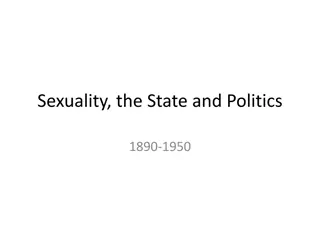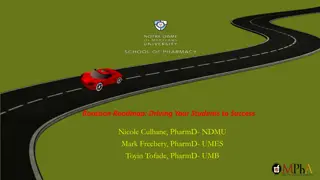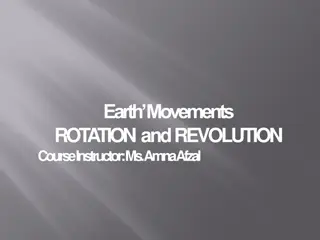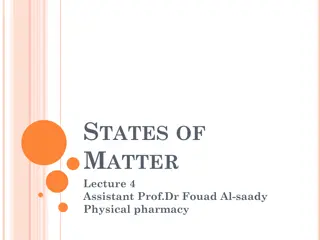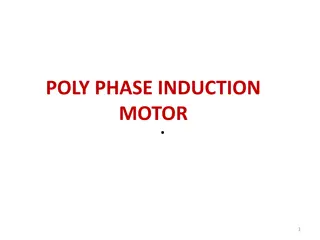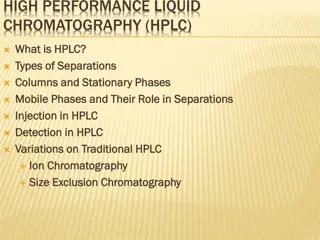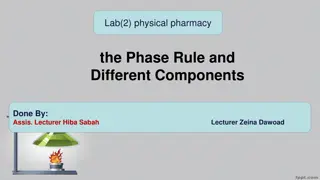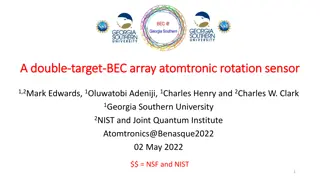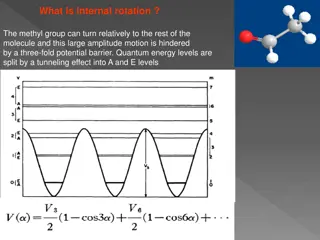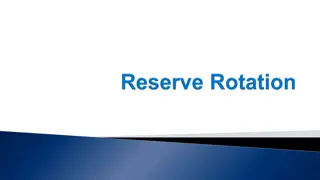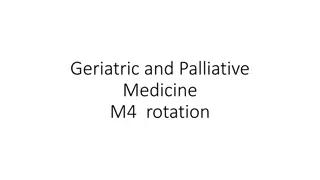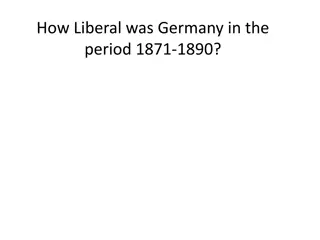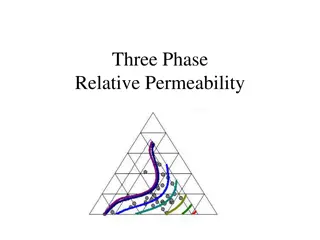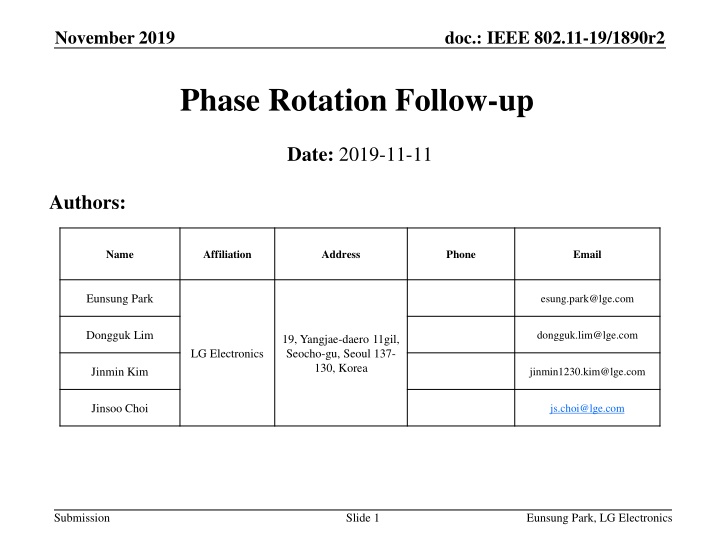
IEEE 802.11-19/1890r2 Phase Rotation Proposal for EHT PPDU
Explore the November 2019 document outlining the IEEE 802.11-19/1890r2 proposal for phase rotation in EHT PPDU to mitigate PAPR. Detailed discussions on optimized coefficients, bandwidth allocation, and options for phase rotation design in 320MHz are presented.
Download Presentation

Please find below an Image/Link to download the presentation.
The content on the website is provided AS IS for your information and personal use only. It may not be sold, licensed, or shared on other websites without obtaining consent from the author. If you encounter any issues during the download, it is possible that the publisher has removed the file from their server.
You are allowed to download the files provided on this website for personal or commercial use, subject to the condition that they are used lawfully. All files are the property of their respective owners.
The content on the website is provided AS IS for your information and personal use only. It may not be sold, licensed, or shared on other websites without obtaining consent from the author.
E N D
Presentation Transcript
November 2019 doc.: IEEE 802.11-19/1890r2 Phase Rotation Follow-up Date: 2019-11-11 Authors: Name Affiliation Address Phone Email Eunsung Park esung.park@lge.com Dongguk Lim dongguk.lim@lge.com 19, Yangjae-daero 11gil, Seocho-gu, Seoul 137- 130, Korea LG Electronics Jinmin Kim jinmin1230.kim@lge.com Jinsoo Choi js.choi@lge.com Submission Slide 1 Eunsung Park, LG Electronics
November 2019 doc.: IEEE 802.11-19/1890r2 Introduction In the September F2F meeting, TGbe agreed that EHT PPDU starts with the legacy preamble part 11be supports 320 MHz and 160+160 MHz PPDU In [1], we discussed the phase rotation which is applied to the legacy preamble part of EHT PPDU to reduce PAPR In this contribution, we propose several options for the phase rotation in 320 / 160+160 MHz Submission Slide 2 Eunsung Park, LG Electronics
November 2019 doc.: IEEE 802.11-19/1890r2 Assumptions Each coefficient of the phase rotation is employed to each 20MHz channel Candidates for each coefficient of the phase rotation are 1, -1, j, -j for simplicity We consider PAPR of L-LTF to obtain optimized coefficients while PAPR is investigated for all legacy preamble parts, i.e., L- STF, L-LTF and L-SIG When calculating PAPR, contiguous 320MHz bandwidth and 4x IFFT are considered Submission Slide 3 Eunsung Park, LG Electronics
November 2019 doc.: IEEE 802.11-19/1890r2 Phase Rotation (1/3) We take account of two cases as follows to obtain an optimized phase rotation and to investigate PAPR for various options Case 1: entire bandwidth allocation (i.e., non-preamble puncturing) Case 2: 20MHz based preamble puncturing We also consider the following options to design a phase rotation in 320MHz Option 1: repeat 11ax 80MHz phase rotation Option 2: repeat 11ax 80MHz phase rotation and apply additional coefficients to 80MHz segments Option 3: repeat new 80MHz phase rotation which is optimal in 80MHz when considering Case 2 Option 4: repeat new 80MHz phase rotation and apply additional coefficients to 80MHz segments Note that additional coefficients in option 2 and 4 are optimized considering either case 1 or case 2 Slide 4 Submission Eunsung Park, LG Electronics
November 2019 doc.: IEEE 802.11-19/1890r2 Phase Rotation (2/3) Option 1 [1 -1 -1 -1 1 -1 -1 -1 1 -1 -1 -1 1 -1 -1 -1] Option 2 A*: [1 -1 -1 -1 j -j -j -j j -j -j -j 1 -1 -1 -1] B**: [1 -1 -1 -1 j -j -j -j 1 -1 -1 -1 j -j -j -j] Option 3 [1 1 -1 -1 1 1 -1 -1 1 1 -1 -1 1 1 -1 -1] PAPR comparison for 80MHz between 11ax phase rotation and new one ([1 1 -1 -1]) is shown in Appendix A Option 4 A*: [1 1 -1 -1 j j -j -j -j -j j j -1 -1 1 1] B**: [1 1 -1 -1 1 1 -1 -1 j j -j -j -j -j j j] *: additional coefficients applied to 80MHz segments are optimized considering Case 1, i.e., entire bandwidth allocation **: additional coefficients applied to 80MHz segments are optimized considering Case 2, i.e., 20MHz based preamble puncturing Submission Slide 5 Eunsung Park, LG Electronics
November 2019 doc.: IEEE 802.11-19/1890r2 Phase Rotation (3/3) PAPR Unit: [dB] Case 1 Case 2 (max PAPR*) L-STF L-LTF L-STF L-LTF Option 1 8.2600 9.1864 12.8812 13.9576 5.5493 6.3714 A 11.4481 12.5284 Option 2 B 8.2167 9.2159 10.7392 11.8183 Option 3 11.2703 11.8144 11.2703 12.1967 10.6648 A 7.3583 8.4605 11.7440 11.7023 Option 4 B 8.8950 9.6281 10.8912 In Appendix B, PAPR for the L-SIG part is shown Its trend is the same as that of L-STF or L-LTF *: Various 20MHz based preamble puncturing patterns can be considered which have different PAPRs, and thus, we only present the maximum PAPR Submission Slide 6 Eunsung Park, LG Electronics
November 2019 doc.: IEEE 802.11-19/1890r2 Discussion In case 1 Option 2-A is the best followed by Option 4-A Option 1 and Option 2-B follow Option 4-A and have similar PAPR In case 2 Option 2-B, Option 4-A and Option 4-B have similar and relatively low PAPR If we consider a unified phase rotation Option 4-A is desirable because it has a relatively good PAPR in case 1 and it is one of the best options in case 2 Option 2-B is also worth considering because it has comparable PAPR and reuses the conventional phase rotation The best option is not the same between case 1 and case 2, and thus, we can consider different phase rotation values according to whether 20MHz based puncturing is applied or not For a simple implementation, we can unify the phase rotation when 20MHz based puncturing is applied Submission Slide 7 Eunsung Park, LG Electronics
November 2019 doc.: IEEE 802.11-19/1890r2 Conclusion We have proposed various options for the phase rotation employed to the legacy preamble part in 320 / 160+160 MHz and have shown their PAPR as well Our preference is depending on whether 20MHz based puncturing is applied If 20MHz based puncturing is not applied, we prefer Option 2-A If 20MHz based puncturing is applied, we prefer Option 4-A, Option 4-B or Option 2-B Submission Slide 8 Eunsung Park, LG Electronics
November 2019 doc.: IEEE 802.11-19/1890r2 Straw Poll #1 Do you agree that preamble puncturing can be considered in order to design phase rotation for 320/160+160 MHz? Note : not intended to include in SFD Y/N/A: 9/0/31 Submission Slide 9 Eunsung Park, LG Electronics
November 2019 doc.: IEEE 802.11-19/1890r2 Straw Poll #2 Which option do you prefer for the phase rotation in 320/160+160 MHz Option 1: Unified phase rotation regardless of whether the preamble puncturing is applied or not Option 2: Different phase rotation according to whether the preamble puncturing is applied or not Note: not intended to include in SFD Option 1/Option 2/A: 11/13/22 Submission Slide 10 Eunsung Park, LG Electronics
November 2019 doc.: IEEE 802.11-19/1890r2 Straw Poll #3 Do you agree to add the following text to the TGbe SFD? [1 -1 -1 -1 j -j -j -j j -j -j -j 1 -1 -1 -1] is used for the phase rotation in 320/160+160 MHz when the preamble puncturing is not applied Y/N/A : // Submission Slide 11 Eunsung Park, LG Electronics
November 2019 doc.: IEEE 802.11-19/1890r2 Straw Poll #4 Do you agree to add the following text to the TGbe SFD? [1 -1 -1 -1 j -j -j -j 1 -1 -1 -1 j -j -j -j] is used for the phase rotation in 320/160+160 MHz when the preamble puncturing is applied Y/N/A : // Submission Slide 12 Eunsung Park, LG Electronics
November 2019 doc.: IEEE 802.11-19/1890r2 Straw Poll #5 Do you agree to add the following text to the TGbe SFD? [1 1 -1 -1 j j -j -j -j -j j j -1 -1 1 1] is used for the phase rotation in 320/160+160 MHz regardless of whether the preamble puncturing is applied or not Y/N/A : // Submission Slide 13 Eunsung Park, LG Electronics
November 2019 doc.: IEEE 802.11-19/1890r2 References [1] 802.11-19/1493r0 Phase Rotation for 320MHz Submission Slide 14 Eunsung Park, LG Electronics
November 2019 doc.: IEEE 802.11-19/1890r2 Appendix A PAPR comparison for 80MHz 11ax phase rotation: [1 -1 -1 -1] New phase rotation: [1 1 -1 -1] Unit: [dB] Case 1 Case 2 (max PAPR) L-STF L-LTF L-STF L-LTF 11ax phase rotation 4.4380 5.3962 6.8606 7.9370 New phase rotation 5.8847 6.6178 5.8847 6.6178 1 L-SIG 0.9 0.8 0.7 0.6 CDF 0.5 0.4 0.3 11ax in case 1 11ax in case 2 New in case 1 New in case 2 0.2 0.1 0 0 5 10 15 20 25 PAPR [dB] Submission Slide 15 Eunsung Park, LG Electronics
November 2019 doc.: IEEE 802.11-19/1890r2 Appendix B PAPR for L-SIG Case 2 Case 1 1 0.9 0.8 0.7 0.6 CDF 0.5 0.4 Option 1 Option 2A Option 2B Option 3 Option 4A Option 4B 0.3 0.2 0.1 0 0 5 10 15 20 25 PAPR [dB] Submission Slide 16 Eunsung Park, LG Electronics
November 2019 doc.: IEEE 802.11-19/1890r2 Appendix C PAPR for the Data part Case 2 Case 1 1 1 BPSK QPSK BPSK QPSK 0.9 0.9 0.8 0.8 0.7 0.7 0.6 0.6 CDF CDF 0.5 0.5 0.4 0.4 0.3 0.3 0.2 0.2 0.1 0.1 0 0 0 5 10 15 20 25 0 5 10 15 20 25 PAPR [dB] PAPR [dB] Submission Slide 17 Eunsung Park, LG Electronics

